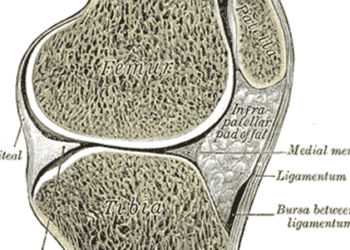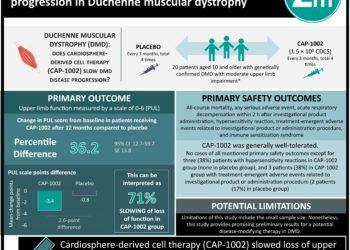Correcting NAD+ depletion may improve muscular degeneration in Duchenne muscular dystrophy [PreClinical]
1. Dietary supplementation with nicotinamide riboside (NR), a form of vitamin B3 that acts as a precursor to nicotinamide adenine dinucleotide (NAD+), increased levels of NAD+ and reduced deterioration of muscle structure in mouse models of Duchenne muscular dystrophy (DMD).
2. Concomitantly, NR treatment led to improved mitochondrial energetics and function of cardiac and skeletal muscle.
Evidence Rating Level: 2 (Good)
Study Rundown: Neuromuscular diseases like DMD are marked by severe muscle weakness and degeneration and often cause death by heart or respiratory failure. Though research has focused on correcting genetic mutations that cause the disease, there are currently no therapeutic treatments for DMD. In this work, researchers demonstrated the efficacy of a member of the vitamin B3 family, NR, in preventing the progression of DMD.
Baseline NAD+ levels in mice with DMD (mdx mice) were first determined, and compared to wild-type animals, mdx mice demonstrated significantly lower NAD+ content in samples from skeletal muscle. As expected, dietary supplementation with NR effectively enhanced NAD+ content. Histological analysis of skeletal muscle indicated significant increases in the average size of muscle fibers, reduced inflammatory infiltration, and reduced fibrosis after NR treatment. Similar improvements to tissue structure were also seen samples of cardiac tissue from NR-treated mice. Finally, the functional consequences of NR treatment were investigated. As compared to the control treatment group, the NR-treated mice demonstrated increased mitochondrial capacity of the hindlimb muscle and reduced energy stress, allowing mdx mice to improve performance during an endurance test.
Overall, this work provides encouraging evidence that supports the use of NR to slow the deterioration of muscle structure and function caused by DMD and, potentially, other diseases related to muscular dystrophy. Because NR is orally available and readily accessible as a vitamin supplement, the potential for NR to be adapted for patient use is promising. However, more detailed, long-term efficacy testing will be needed before clinical applications can be pursued.
Click to read the study in Science Translational Medicine
Relevant Reading: PARP-1 Inhibition Increases Mitochondrial Metabolism through SIRT1 Activation
In-Depth [animal study]: Levels of NAD+ in 16-week old C57BL/10ScSn-Dmdmdx/J mice and wild-type (WT) C57BL/10SnJ mice were measured from tissue samples of the gastrocnemius muscle using 31phosphorous magnetic resonance spectroscopy (31P MRS) techniques; NAD+ concentrations in mdx mice were about twice as low as that of WT mice (p<0.001). In 4-week old mice, dietary supplementation with NR (400 mg/kg per day) for 12 weeks increased NAD+ levels in the hindlimb muscles by nearly 70% and by almost 2-fold in the gastrocnemius muscle (p<0.05).
Tissue samples from control and NR-treated mice were evaluated via histological analysis. The average minimal Feret’s diameter and cross-sectional area of tibialis anterior muscle fibers significantly increased with NR therapy (p<0.001). CD45 staining also demonstrated a reduced presence of inflammatory cells in the diaphragms of NR-fed mdx mice. This was accompanied by diminished fibrosis, as measured by Picrosirius red staining. Likewise, NR-treated mice demonstrated minimized necrosis and fibrosis of cardiac tissue, determined by H&E and Masson’s trichrome staining.
To measure mitochondrial energetics, high-performance liquid chromatography and 31P MRS were used to determine basal ATP levels, the PCr/ATP ratio, resting ATPase activity, and recovery of ATPmax levels in NR-supplemented mdx mice. While resting ATPase activity and basal ATP levels did not change, ATPmax concentrations in NR-fed mice were significantly higher than in the control group (p<0.05), thus leading to a higher PCr/ATP ratio (p<0.01). These improved energetics were accompanied by a 2-fold increase in the distance and 1.6-fold increase in the time run during an endurance test.
Image: PD
©2016 2 Minute Medicine, Inc. All rights reserved. No works may be reproduced without expressed written consent from 2 Minute Medicine, Inc. Inquire about licensing here. No article should be construed as medical advice and is not intended as such by the authors or by 2 Minute Medicine, Inc.




![Gene therapy targets Duchenne muscular dystrophy in new trial [PreClinical]](https://www.2minutemedicine.com/wp-content/uploads/2018/10/70_lores-350x250.jpg)


![Type I diabetes not associated with early menopause [OVADIA study]](https://www.2minutemedicine.com/wp-content/uploads/2014/12/diabetes1_edited-75x75.jpg)